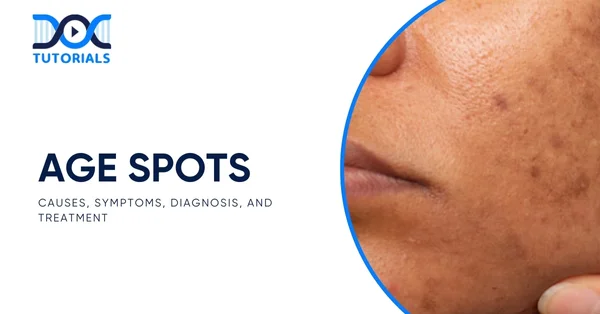Age Spots: Causes, Symptoms, Diagnosis, and Treatment

Age spots are one of the common changes in skin, appearing in the form of darkened, flat, small patches that mostly develop on sun-exposed parts of the body, including the face, hands, shoulders, and arms. Even though they do not cause any harm, most people prefer to treat them because of cosmetic reasons.
As a NEET PG candidate, the causes, symptoms, modes of diagnosis, and treatment approaches to age spots are some of the key factors that you should know to make a precise clinical assessment. This comprehensive guide will enhance your preparation and support the development of clinical reasoning skills.
Keep reading for a detailed insight into age spots.
What are Age Spots?
Age spots are flat patches of brown, grey, or black pigmentation that appear on the skin, most often in areas exposed to sunlight, such as the face and the backs of the hands. They are also referred to as liver spots, senile lentigo, solar lentigines, or sun spots.
A single age spot may develop on its own, or several may form in clusters. Though they may develop at any age, even in childhood, they are most common in middle-aged and older adults and in persons who have had years of sun exposure.
What are the Causes of Age Spots?
The liver spots do not disappear over time, as the case is with freckles or temporary blemishes. It is thus important to know the factors that lead to their occurrence, which include:
- Sun Exposure
Excessive exposure to sunlight is the primary cause of age spots. These marks develop in areas where melanin, the pigment that gives skin its colour, is concentrated. Ultraviolet light stimulates melanin production, and prolonged sun exposure over the years can lead to the formation of sunspots.
- Medical Treatments (Radiation Therapy)
Radiation therapy can make the epidermis highly sensitive. The side effects depend on the area of the body treated, but over time, cumulative sun damage and previous radiation exposure can result in the development of age spots on exposed skin.
- Smoking
Although sunlight is one of the principal causes of age spots on face, smoke emitted by cigarettes can also be even more harmful. Studies indicate that smoking causes a rise in melanin in the skin, hence causing dark spots, especially on the face.
- Poor Diet
There have been reports on how poor eating habits and poor nutrition may hasten the ageing process of the skin. When the body does not receive enough nutrient-rich foods, skin cells lose vitality, leading to dullness, dark patches, and the development of age spots.
- Inadequate Sleep
Poor quality sleep may make the skin age prematurely, become less elastic and have crinkles. Sleep deprivation decreases repair and regeneration of the skin, and thus, people will have the look of older individuals and have more chances of developing age spots.
- Pollution
Air pollution, even outside industrialised cities, affects more than just the respiratory system. Studies have shown that our daily exposure to environmental toxicants leads to and accelerates the occurrence of dark spots, which are commonly associated with ageing.
- Genetics
A hereditary tendency can also increase the risk of age spots. Individuals with a family history of the condition are more likely to develop it.
What are the Risk Factors of Age Spots?
The following are the risk factors of age spots:
- Age above 40 years
- Fair skin tone
- History of long-term sun exposure
- Frequent use of tanning beds
What are the Symptoms of Age Spots?
The key symptoms that define age spots are as follows:
- Colour: These spots may appear in shades ranging from light brown to black and can become darker after sun exposure.
- Texture: They share the same texture as the surrounding skin, usually developing on areas exposed to sunlight. They are flat and do not cause pain.
- Size: They might be as small as a freckle or as big as an inch across.
- Grouping: They can grow on their own or in groups, which makes them easier to see.
- Shape: They are usually circular or oval with sharp edges.
How to Diagnose Age Spots?
Age spots are identified through the following methods:
- Visual Examination
Doctors often diagnose age spots through direct observation of the skin. There is a strong need to distinguish between age spots and other skin disorders because the treatment methods differ, and using the inappropriate method can postpone the care required for other conditions.
- Skin Biopsy
In some cases, further testing is performed, such as removing a small section of skin for laboratory analysis. This procedure, known as a skin biopsy, helps distinguish age spots from conditions like lentigo maligna, a form of skin cancer. It is generally carried out in a clinic using local anaesthesia.
What are the Treatment Options for Age Spots?
A range of medical procedures and therapies can help reduce the appearance of age spots. These include:
- Cryotherapy
In this technique, liquid nitrogen is applied to the area of excess pigment using a cotton-tipped swab and left there for five seconds or less to destroy the excess pigment. As the skin heals, it appears lighter. Spray freezing can be used for clusters of spots. Side effects may include temporary irritation and, rarely, permanent scarring or discolouration.
- Medications
Prescription bleaching creams containing hydroquinone, either alone or combined with retinoids such as tretinoin and a mild steroid, can gradually lighten age spots over several months. These treatments may cause temporary itching, redness, burning, or dryness.
- Laser and Intense Pulsed Light (IPL) Therapy
Certain laser and IPL techniques target and destroy melanin-producing cells (melanocytes) without harming the skin’s surface. Typically, two to three sessions are required. Ablative lasers, on the other hand, remove the epidermis entirely.
- Dermabrasion
This procedure sands down the skin’s surface using a rapidly rotating brush, allowing new skin to grow. Multiple sessions may be necessary. Side effects include temporary redness, swelling, and scabbing, with pinkness sometimes lasting for several months.
- Microdermabrasion
A gentler alternative to dermabrasion, this technique smooths mild blemishes. Results are modest and temporary, often requiring several months of treatment. Side effects may include slight redness or stinging. It is not recommended for those with rosacea or visible facial veins, as it can worsen these conditions.
- Chemical Peels
A chemical solution is applied to remove the upper layers of skin, allowing smoother new skin to form. Risks include scarring, infection, and changes in skin pigmentation. Redness may persist for several weeks, and multiple treatments are often required to see results.
What are the Different Ways to Prevent Age Spots?
Several measures can help reduce the risk of developing liver spots and prevent new ones from appearing after treatment. These include:
- Applying Sunscreen
A broad-spectrum sunscreen with a sun protection factor (SPF) of at least 30 should be applied generously 15 to 30 minutes before going outdoors. Reapplication every two hours is essential, with more frequent application during swimming or heavy perspiration.
- Wearing Protective Clothing
Tightly woven garments that cover the arms and legs, along with a broad-brimmed hat, provide effective protection from the sun. A wide-brimmed hat offers better coverage than a baseball cap or visor.
- Regular Skin Examinations
Skin should be monitored regularly for any unusual changes, with prompt medical consultation if anything concerning is noticed.
- Maintaining a Healthy Diet
Foods rich in vitamins C and E can support skin health and help protect against oxidative stress, which contributes to skin damage.
FAQs about Age Spots
- What are age spots?
Age spots are flat pigmented areas of the skin characterised in colour as light brown to dark brown or black. They appear most commonly in areas of the body that are exposed to the sun, including the face, hands, shoulders and arms.
- Which foods help prevent age spots?
Foods with high antioxidants are able to enhance the skin and reduce darkening. The most beneficial ones are as follows:
- Citrus fruits
- Pumpkin
- Sweet potatoes
- Berries
- Legumes
- Zinc-content fatty fish
- Do liver spots pose a health risk?
Liver spots tend to be non-cancerous, but this possibility should be ruled out by a medical expert by examining any observable variation in the size, shape, or colour of liver spots.
- What causes liver spots to develop?
The liver spots on face, legs and feet develop mostly out of overactive pigment-secretion cells that get activated due to the exposure to ultraviolet (UV) rays. By being exposed to sunlight for a long period of time, the amount of melanin produced may accumulate in some parts.
This develops more rapidly as we age, and those with fair skin or who spend a lot of time in the sun are more prone to it
- Do age spots pose a health risk?
In most cases, age spots are benign. However, any changes relevant to their structural features (size, shape, colour) should be evaluated by a medical specialist to rule out skin cancer.
Conclusion
Age spots are common signs of skin ageing, mainly triggered by prolonged sun exposure and influenced by various lifestyle and environmental factors. While they are generally harmless, it is essential to recognise their features, distinguish them from other skin conditions, and know the available treatment options. Preventive strategies can significantly reduce their occurrence.
As a NEET PG candidate, knowledge of age spots is crucial to make a proper diagnosis during clinical practice, as well as covering the exam syllabus. DocTutorials gives concise video lectures, mock tests, revision programmes and professional counselling to aid you in your exam preparation.
Visit our NEET PG course and take a step forward to your dream medical seat!
Latest Blogs
-

NEET PG Exam 2025- Date, Pattern, Marking Scheme, Subject Wise Weightage, and Exam Mode
NEET PG Exam 2025 is the ultimate gateway for medical graduates aspiring to pursue postgraduate courses in medicine, including MD,…
-

INI CET Exam 2025: Your Roadmap to Success – Key Topics, Strategies, and Lessons from Last Year’s Papers
The INI CET exam is more than just a test; it’s a significant milestone for many medical students aiming to…
-

INI CET Exam Success: Previous Year Question Papers & Ultimate Guide – INI CET PYQ
One can feel overwhelmed while preparing for the INI CET (Institute of National Importance Combined Entrance Test). A vast syllabus,…




